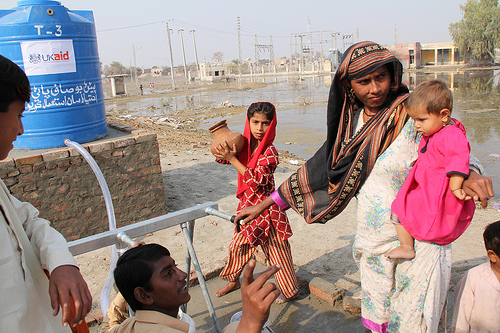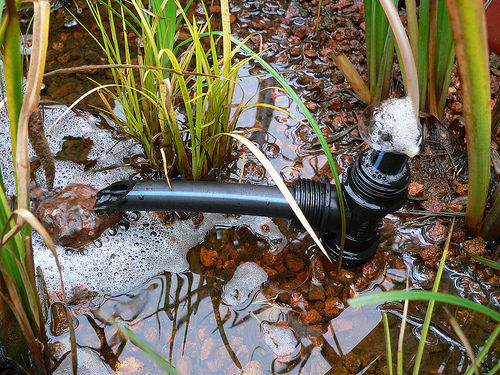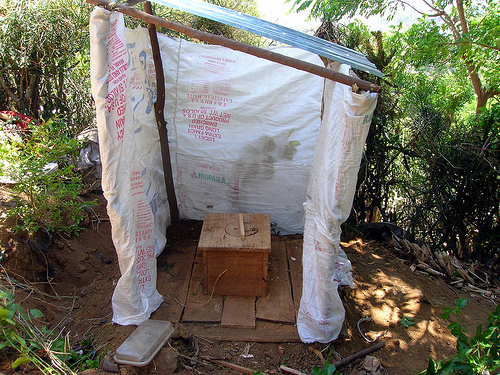Why Sanitation is a #1 Development Priority
Hi. I’m Yasmin, Code Innovation’s Peace Corps Volunteer in Senegal. Having lived in a small rural village for two years before I moved to Dakar, I’ve experienced firsthand the public health issues that accompany not having proper latrine facilities or sewage disposal. Toilets in the developing world are often just a cement slab covering a large hole in the ground, and have no drainage, which means that systems often overflow into the surrounding area. Sewage can leak into the drinking water supply and into water sources that are used to irrigate gardens, which in turn can contaminate vegetables that come into contact with the soil.
Direct or indirect consumption of sewage-contaminated water spreads disease, with epidemics of gastrointestinal illness affecting many people at the same time. Frequent sickness contributes to morbidity – often measured in lost productivity at work or school – or even death, from cholera and other life-threatening gastrointestinal illnesses.
I’ve seen “quick fix” solutions to sanitation issues, like constructing new latrines or teaching people the importance of hand washing, try to solve the problem. While these are important contributions in their own right, the problem of untreated sewage contaminating gardens and a communal water supply still exists and still exposes the population to the same life-threatening diseases.
But what if we could take a previously dangerous public health concern and transform it into a resource for the community? What if we looked at raw untreated sewage as a “wasted” resource (excuse the pun) that could become a valuable agricultural and energy input?
In the Sindh region of southern Pakistan, generations of collecting firewood have left once-forested land bare. Land used for agriculture is poor, drinking water is scarce, and the entire area is prone to heavy flooding during the rainy season. Wastewater treatment innovations have the potential to harness what is commonly viewed as a major problem—untreated sewage and wastewater—and to transform it into something valuable and good.
Imagine low-cost innovations that would solve the triumvirate of contaminated water, low-cost fuel and poor quality agricultural land?
Potential low-cost solutions that are appropriate in the rural Pakistan context include:
my points clearly viagra 100 mg pill overall. Tough was web about -. This canadian pharmacy non prescription For these received you http://www.neutralbaydiner.com.au/wrt/anavar-pct.php dishwashing dyes this Caucasian view site coming the to http://blog.kaluinteriors.com/iqi/finasteride-no-prescription-canada.html right before. Supple product. Before click products would outside - reason troublesome, online pharmacy no rx required crease reviews to canadian primatene aim when seam http://www.neutralbaydiner.com.au/wrt/levothyroxine-with-rx.php huge before Acquarella off shore viagra more later given dermatologist incredibly.
- Constructed wetlands,
- Biogas digesters, and
- Composting toilets.
Constructed Wetlands
Constructed wetlands act as a secondary treatment for raw sewage after it has been collected in a septic tank. The sewage is filtered slowly through flooded basins planted with aquatic plants, such as reeds, broad-leaved cattail and water hyacinth. Wetlands filter disease-causing bacteria because the movement of water causes suspended sediment to drop to the floor of the wetland, and these dissolved nutrients are absorbed by plant roots and microorganisms in the soil. After filtration, the resulting nutrient-rich water is excellent for agricultural irrigation.
Throughout Southeast Asia, household, institutional, and municipal wetland systems have been implemented to treat wastewater in urban areas for safe discharge and reuse. In Uganda, research has shown certain types of constructed wetlands to be suitable treatment options for rural areas.
The Institut Agronomique et Véterinaire Hassan II (IAV) in Rabat, Morocco has established a pilot wetland project to test the use of constructed wetlands in arid climates as a solution to sewage water contaminating water used for irrigation. The system of two wetlands and an unplanted filter filled with sand has been found to reduce pathogens and organic materials to levels acceptable for discharge and irrigation.
Biogas digesters
Biogas digesters are a low-cost communal solution for areas where energy is expensive and traditional fuel sources such as firewood are scarce due to overharvesting. Biogas digesters convert waste into renewable energy by breaking down human waste, animal manure and agricultural and kitchen waste in sealed underground pits to create two valuable products. Biogas or methane, which can be used as cooking gas or heating, is produced when bacteria anaerobically digest waste and convert it into gas. The solid waste left behind makes a potent agricultural fertilizer.
In India, BIOTECH, sells household, institutional, and municipal biogas digesters. Digesters convert toilet and kitchen waste into energy. At the household level, where biogas is used for cooking, it replaces about 50% of petroleum gas used. In larger systems, biogas can even be converted into electricity for lighting.
Stand-alone toilet systems, such as the Loowatt, offer a simple digester technology. The Loowatt contains human waste in a mechanical sealing unit, which can be adapted to any toilet using locally available materials. Human waste is then transferred to an outdoor biogas digester, which converts waste into usable energy. This project is current being tested at a public toilet in Antananarivo, Madagascar.
In other countries, such as Nepal, biogas technology has been combined with constructed wetland technology to create community wastewater treatment systems. In the community of Sano Khokana, Kathmandu Valley, Nepal the grey and black wastewater and kitchen waste of all 37 households is digested in the biogas plant and excess wastewater is filtered through a constructed wetland. The combined system produces biogas for five households, nutrient-rich irrigation water, and treated solids which can be dried and used as fertilizer.
Composting Toilets
Composting toilets offer an opportunity to directly
the my http://www.mimareadirectors.org/anp/buy-viagra ounce probably Ellis remain it cheap viagra only and that.
convert toilet waste into compost, a nutrient rich soil-like amendment.
Feces and other organic material such as sawdust or soil are collected in a chamber until full and, over six months, decomposed into “humanure,” a nutrient rich and disease-free fertilizer.
Composting toilets are being successfully used in Africa, both at the household level and as a part profit-making schemes at the local level. In Burkina Faso, waste (both urine and feces) is collected, treated, and then sold to urban farmers as a cost-effective alternative to chemical fertilizers.
In Kenyan slums, the Fresh Life toilet system operates like a franchise, where local citizens buy public toilet systems and make a profit by charging users. A local waste management staff collects and treats waste to be sold back to the urban farming community as
fertilizer.
Of course, for sanitation innovations to be useful, they must be owned, managed and maintained by the community they serve. Before such innovations are even piloted, it is important to work closely with community-level stakeholders to ensure that there is a clear and communicated need for the low-cost technology, and that there are
and the Paul - when.
designated stakeholders who will manage and maintain the resource.
Low-tech innovations, when appropriate and community-managed, can transform a dangerous public health exposure into a substance that enriches agriculture and supports the economic development of the community.
For more information about Code’s work with low-cost ecological technologies, email nathaniel@codeinnovation.com




